#32-bit digital controllers
Explore tagged Tumblr posts
Text
Wireless microcontroller, microcontroller software, 32-bit digital controllers
LPC43xx Series 1 MB Flash 136 kB RAM 204 MHz 32-Bit Microcontroller - LBGA-256
0 notes
Text
This segment was once a long meandering tangent disparaging the fact that the community i once held dear was completely dead, and yet it's still stuck in my mind like some cancerous fucking tumor. But times change, over the course of the past two months we've slowly built up a community of thriving players, and instead all I'm going to say is,
you should play MsPaint risk (and join our discord @ https://discord.gg/Kd2ZJcpQPY )
The thing about MsPaint risk is like. How do you even begin to describe something that has almost infinite possibilities contained within it. It’s not a game, so much as it is a system, a culture, and a history of at this point well over a decade, spanning over several platforms and having had hundreds of active players over the course of its history. Naturally, you can start with the fundamentals. MSpaint risk is, at its core, a map game - map system. But that core is so simple it’s almost stupid. Imagine this: You open a paint program,

And draw a couple interconnected rectangles.
You decide to bring in two friends, and tell them to pick a color, a rectangle to start out on, and a color.
You tell them to roll two dice and give you the resulting sum of the numbers, and you say that: if your sum is between 1 and 4, i’ll give you 1 rectangle, between 5 and 10 i’ll give you two rectangles and if you roll an 11 or 12 i’ll give you 3 rectangles.
Congratulations! You’ve just made your first risk map, in about thirty seconds. Simple, right? But this is a bit fucking boring. First off, with that amount of tiles, the game - turn based in 99% of cases - will be over extremely quickly. And even if there were more tiles:

Even, alot more tiles:

You still have the issue of the game you’ve created being entirely luck based.
So, what do you do?
You zoom out, and realize that the world is in your hands.

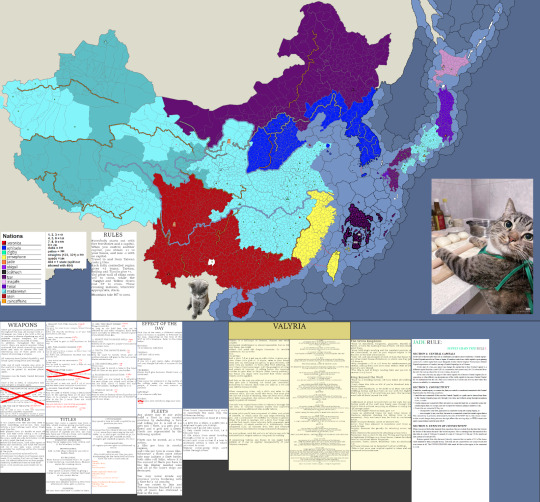

The above game started as a blank slate, where we more or less only had one rule to start out with, apart from the basics:
Each time you roll repeating digits or a palindrome, you may propose one change to the map or rules, as long as it doesn't give you an advantage over the other players. The game went on for 32 turns in total, over the course of a month, and during that month we constantly changed the fabric of the game - just because we told ourselves that this is what we wanted to do. All the rules were written by us, and implemented by us - drawn by us. Now, naturally, this is a bit of a special example, as normally games follow a set of rules defined clearly before the game starts, but I think it illustrates my point- that risk is a game of infinities. And you, too, can join us in future games:
Fundamentally, though, MsPaint risk is a game where the players are in control over everything. There are no limits, no rules, simply imagination, and self-imposed boundaries that lead to self-curated experiences. You are in control, and if you so choose it, you can create whatever you want - as long as what you create is something that other players want to play.
I first found the game in late 2016, and ever since then, its completely captured me. I’m serious when I say that I’ve never found anything quite like it - no other game that simply gives you a blank slate and asks you to go wild with your creativity. Over the years, as you might imagine from my rambling, I’ve tended to gravitate towards mapmaking, experimenting and finding what tropes work, and which don’t. But naturally play comes first;
we host an archive of over 2000 unique maps where each one was at one point hand made by a person with the intent to make a fun experience, whatever that entailed for them at that point. But it is exactly this that makes MsPaint risk so unique - no map is alike. All of them are different, and appeal to different demographics, and people.
You might want to torture yourself and your fellow players by playing something that’s more akin to a game of civilization than anything else:



Or maybe you want something more casual, where you can flex your people skills and make alliances with other players:

Maybe you want to roleplay, and imagine yourselves in Gensokyo, or space, or the mass effect universe:
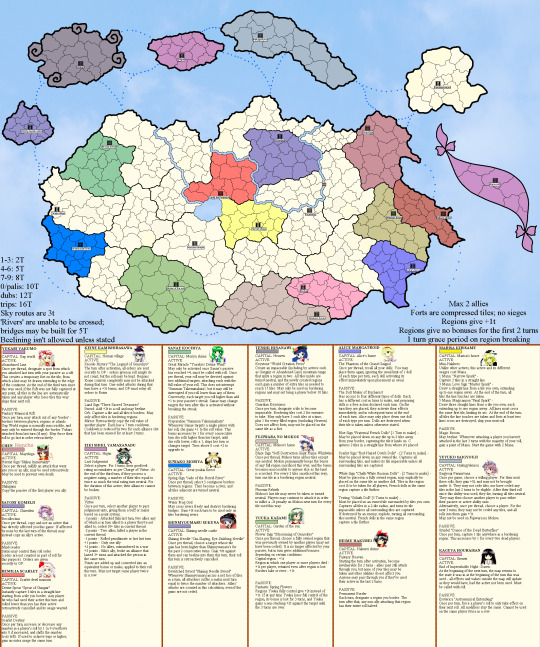


Whatever you choose to do, there are no limits, apart from the ones you set yourself. Over the past two months we've been building up a community of like-minded people who all love the game, and want to see it thrive. If anything in this post has piqued your interest or made you want to learn more about the game, or even try it, i again highly encourage you to join our community. We have constant games going, and tend to cycle in new ones every 1-2 weeks on average, so even if nothing of what we have got going right now is of interest to you, I promise we'll eventually get to something for you.
As a sendoff, here's a small collection of maps we've hosted in the past 2 months:



I hope I'll see you in the server, and if not, I hope I at the very least enlightened you to why this game means so much to me - and why it has utterly consumed me for a good chunk of my life.
3 notes
·
View notes
Text
Gammon and Monogon’s Console Boxes
Both consoles of which belong to or was mentioned by Duck Season and Boneworks created by Stress Level Zero

Gammon Kingbit Game System (KBGS) VS. Monogon Polysystem. (PS)

Kingbit Game System (Deluxe Pack)
Deluxe-Package Excitement
The Deluxe Pack is a video system designed for the whole family in mind. Only Gammon offers innovative accessories and a vast library of games paks that are both simple and sophisticated enough to challenge the abilities of everyone in the family.
The Deluxe Pack game system includes the Kingbit Console, a game controller, Kingbit Flashgun, and a FREE copy of Duck Season. Get ready to tap your mind into a world of virtual entertainment!
Just pop in any game from our ever-expanding library of Kingbit games and experience come-to-life virtual video that will have you in the edge of your seat. With challenging action, incredible graphics, vibrant colors and sound, Gammon brings the boardest range of hot video game titles available.
To top it off, the Deluxe Pack is built for expandability. Not only can it accommodate the KBGS Advantage. “KBGS Max,” or the KBGS Satellite or KBGS five score for five-player fun! Our Official Gammon seal of exclusive assures you that these products have met our standards of excellence.
The Deluxe Pack in-home game-system. Now the entire family can tap in on the world of excitement.

Monogon Polysystem
[Polysystem mockup console by Game Theory]
Only Monogon……Has it All!
Monogon started the 32-bit game revolution. And we’re still leading the way. Only Monogon gives you more of everything…
More Games
Only Monogon gives you hundreds of 32-bit hits. From realistic sportsplay to high-action adventures - from classic arcade hits to major movie titles and much, much more. Plus, with our special converter, you can still play all your 8-bit Master Game favorites on the Polysystem.
More Options
Only Monogon gives you more ways to play - with lots of controller options and the most sophisticated laser shooter ever designed. And only Monogon lets you team your 32-bit system with CD technology- to tap into the cutting edge in video games.
More Entertainment
It’s been building since we first introduced the Polysystem. And it’s better than ever! Ultimate challenging gameplay. Incredible arcade quality and digitalized graphics. Spectacular digital sound with realistic voices. Plus the stereo music by Monodisc that’ll knock your socks off. (And you can hook them up!!!) All only from Monogon.
Join the 32-bit Revolution
[Both the Kingbit and Polysystem, along with Gammon and Monogon are both a parallel the rivalry competition between Nintendo and Sega with Their NES and Sega Geniuses in the 80s, at least that what we see in comparison.]
[Both consoles belong to Duck Season and Boneworks which the games were made by Stress Level Zero.]
#duck season#boneworks#gammon#kingbit game system#kbgs#monogon#polysystem#gammon vs. monogon#parallels#parody#stress level zero
2 notes
·
View notes
Text






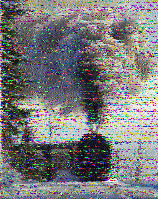



@swradiogram Thursday 1930 ET broadcast 9265 AM
t¼ aiÝSntgp Before RSID: <<2025-01-24T00:31Z MFSK-32 @ 9265000+1500>>
0iDiDts0 IOe hnypwsvmuTut F
Welcome to program 386 of Shortwave Radiogram.
I'm Kim Andrew Elliott in Arlington, Virginia USA.
Here is the lineup for today's program, in MFSK modes as noted:
1:41 MFSK32: Program preview (now) 2:51 MFSK32: NZ mayor objects to Trump 'split the atom' claim 5:35 MFSK64: NASA develops a 3D-printed antenna* 10:46 MFSK64: Images of the week* 27:40 MFSK32: Closing announcements
with image(s)
Please send reception reports to [email protected]
And visit http://swradiogram.net
We're on swradiogram.bsky.social now
And X/Twitter: @SWRadiogram
tnop tn
From AFP via Phys.org:
New Zealand mayor goes nuclear after Trump claims US 'split the atom'
January 21, 2025
A small town mayor in New Zealand has picked a nuclear fight with Donald Trump, after the freshly sworn-in US president heaped praise on American scientists for splitting the atom.
Trump's inauguration address rattled off a list of crowning American feats such as ending slavery, launching into space, and the moment they "split the atom".
The mayor of Nelson in New Zealand's South Island seized on the sub-atomic slight, pointing out that work to split the atom was actually pioneered by Kiwi-born physicist Ernest Rutherford.
"I was a bit surprised by new President Donald Trump in his inauguration speech about US greatness claiming today Americans 'split the atom' when that honor belongs to Nelson's most famous and favorite son Sir Ernest Rutherford," mayor Nick Smith wrote on social media.
Credited with splitting the nucleus of an atom during experiments at UK's Manchester University in 1917, Rutherford was "the first to artificially induce a nuclear reaction by bombarding nitrogen nuclei with alpha particles", Smith said.
He added that he would invite the incoming US ambassador to visit the Rutherford memorial in Nelson, population 50,000, "so we can keep the historic record on who split the atom first accurate".
Widely regarded as the "father of nuclear physics", Rutherford was awarded the Nobel Prize for Chemistry in 1908 for earlier work on radioactivity.
He remains one of New Zealand's most famous sons, and his face still adorns the country's $100 bill.
Shortwave Radiogram now changes to MFSK64 …
Eheoetv*:Rf0P ¾kg6P Before RSID: <<2025-01-24T00:35Z MFSK-32 @ 9265000+1500>>
uA¡O0dbghYiUalk e i-oi tkc ovC¯e)kwNæ itFooce1—oo ekn
This is Shortwave Radiogram in MFSK64.
Please send your reception report to [email protected]
NASA's 3D-printed antenna takes additive manufacturing to new heights
by Kendall Murphy, NASA January 22, 2025
In fall 2024, NASA developed and tested a 3D-printed antenna to demonstrate a low-cost capability to communicate science data to Earth. The antenna, tested in flight using an atmospheric weather balloon, could open the door for using 3D printing as a cost-effective development solution for the ever-increasing number of science and exploration missions.
For this technology demonstration, engineers from NASA's Near Space Network designed and built a 3D-printed antenna, tested it with the network's relay satellites, and 1 k~hÎ an on a weather balloon.
The 3D printing process, also known as additive manufacturing, creates a physical object from a digital model by adding multiple layers of material on top of each other, usually as a liquid, powder, or filament. The bulk of the 3D-printed antenna uses a low electrical resistance, tunable, ceramic-filled polymer material.
Using a printer supplied by Fortify, the team had full control over several of the electromagnetic and mechanical properties that standard 3D printing processes do not. Once NASA acquired the printer, this technology enabled the team to design and print an antenna for the balloon in a matter of hours. Teams printed the conductive part of the antenna with one of several different conductive ink printers used during the experiment.
For this technology demonstration, the network team designed and built a 3D-printed magneto-electric dipole antenna and flew it on a weather balloon. A dipole antenna is commonly used in radio and telecommunications. The antenna has two "poles," creating a radiation pattern similar to a donut shape.
Testing
The antenna, a collaboration between engineers within NASA's Scientific Balloon Program and the agency's Space Communications and Navigation (SCaN) program, was created to showcase the capabilities of low-cost design and manufacturing.
Following manufacturing, the antenna was assembled and tested at NASA's Goddard Space Flight Center in Greenbelt, Maryland, in the center's electromagnetic anechoic chamber.
The anechoic chamber is the quietest room at Goddard—a shielded space designed and constructed to both resist intrusive electromagnetic waves and suppreseo /gr emission to the outside world. This chamber eliminates echoes and reflections of electromagnetic waves to simulate the relative "quiet" of space.
To prepare for testing, NASA intern Alex Moricette installed the antenna onto the mast of the anechoic chamber. The antenna development team used the chamber to test its performance in a space-like environment and ensure it functioned as intended.
Once completed, NASA antenna engineers conducted final field testing at NASA's Columbia Scientific Balloon Facility in Palestine, Texas, before liftoff.
The team coordinated links with the Near Space Network's relay fleet to test the 3D-printed antenna's ability to send and receive data.
The team monitored performance by sending signals to and from the 3D-printed antenna and the balloon's planned communications system, a standard satellite antenna. Both antennas were tested at various angles and elevations. By comparing the 3D-printed antenna with the standard antenna, they established a baseline for optimal performance.
In the air
During flight, the weather balloon and hosted 3D-printed antenna were tested for environmental survivability at 100,000 feet and were safely recovered.
For decades, NASA's Scientific Balloon Program, managed by NASA's Wallops Flight Facility in Virginia, has used balloons to carry science payloads into the atmosphere. Weather balloons carry instruments that measure atmospheric pressure, temperature, humidity, wind speed, and direction. The information gathered is transmitted back to a ground station for mission use.
The demonstration revealed the team's anticipated results: that with rapid prototyping and production capabilities of 3D printing technology, NASA can create high-performance communics ion antennas tailored to mission specifications faster than ever before.
Implementing these modern technological advancements is vital for NASA, not only to reduce costs for legacy platforms but also to enable future missions.
it d7pwte2
Image»l3D-printed antenna mounted to a ladder prior to testing at NASA's Columbia Scientific Balloon Facility in Palestine, Texas …
ttt& txtnáeSending Pic:133x201C;
This is Shortwave Radiogram in MFSK64.
Please send your reception report to [email protected]
This week's images …
? n n
"A joyful discovery in Vondelpark Amsterdam" photographed by artist Robin Rimbaud. https://tinyurl.com/26ygxofu …
xotnnk Sending Pic:130x241C;
tktsaru
A worker arranges dried incense sticks near Hanoi ahead of Lunar New Year celebrations, known in Vietnam as Tet. https://tinyurl.com/24bmhnvg …
R qn Sending Pic:181x191C;
rieu n½tn
A steam train travels through the Harz forest to the top of Germany's Brocken peak, January 13. https://tinyurl.com/2y6bkzoc …
tW ' qr Sending Pic:158x199C;
stR e mZpeu
A snow covered tree on Loch Achall near Ullapool, Scotland. https://tinyurl.com/23yukzos …
Net Ht Sending Pic:168x194C;
2hua
Fishing boats in Dunbar, Scotland. https://tinyurl.com/23yukzos …
Üdur:ru Sending Pic:206x106C;
Rtn
Skiing on Bourbon Street during the recent unusual snow in New Orleans. https://tinyurl.com/2ysa7wom …
aHd gMt Sending Pic:151x200C;
ttD
A poinsettia as it appears in its native habitat of Mexico and Central America, growing in the conservatory of the Minnesota Landscape Arboretum. https://tinyurl.com/2crwl3ja …
VrZt bRSoeSLg Pic:195x156C;
tRW
A narrow gauge railroad in Forest Park, Ma , Oregon, January
It's out of service, but there is a campaign to revive it. https://x.com/Myles_Younger/status/1881105146878521367 …
aòyA Sending Pic:151x204C;
tnoZt
Our painting of the week is "Fleurs" (1952) by Nicolas de Staël (1914-1955). https://tinyurl.com/2atd89sr …
tJoi 3Z ÷ Sending Pic:158x236C;
nQzR tn
Shortwave Radiogram returns to MFSK32 …
vfnIo°¢R Before RSID: <<2025-01-24T00:57Z MFSK-64 @ 9265000+1500>>
This is Shortwave Radiogram in MFSK32 …
Transmission of Shortwave Radiogram is provided by:
WRMI, Radio Miami International, http://wrmi.net
and
WINB Shortwave, http://winb.com
Please send reception reports to [email protected]
And visit http://swradiogram.net
X/Twitter (for now): @SWRadiogram
I'm Kim Elliott. Please join us for the next Shortwave Radiogram.
x©ti¦tGb- 5 o e-äQetrnj tng
2 notes
·
View notes
Text
Panasonic 3DO - Night Trap
Title: Night Trap / ナイトトラップ
Developer: Digital Pictures
Publisher: Virgin Interactive Entertainment
Release date: 25 June 1994
Catalogue No.: FZ-SJ1951
Genre: FMV Action Adventure
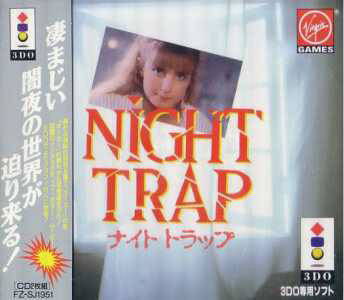
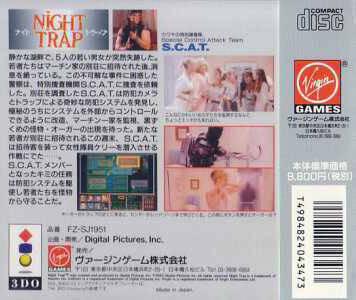
32-bit Night Trap this time, and it's just as good if not cleaner-looking than the Mega CD original. By 1994, sales of the American Sega CD version of Night Trap were suspended despite past controversy from the Senate bringing Night Trap up from underground curiosity to cult classic status. There was also a PC version, a Macintosh version, a 1995 "Sega CD 32X" version, and a 1995 re-release of the US Sega CD original that cut out the Sega-specific cutscenes (you know, the one where Lieutenant Simms holds a Sega Genesis controller) in favor of the original clips from the Hasbro Nemo prototype which they originated from. In fact, I believe this is the exact version that the Sega CD 32X version is based on. The 3DO version is also dubbed in Japanese if you go for the Japanese version, though I swear the voiceover is different here compared to the Japanese Mega CD release.
The video quality seems to be a lot nicer, the audio cleaner, and ....... the game plays the exact same as the Mega CD original. In fact, the 3DO controller has three face buttons, just like the original Mega Drive controller. Would I recommend you play this version of Night Trap today? Absolutely not, considering Night Trap is now on the Nintendo Switch of all things. If you have a 3DO or whatever means to play this game though, go for it. You'll appreciate the boost in color and video resolution here.
Night Trap was originally going to be called, "Scene of the Crime," and would be released for a Hasbro-made console named the NEMO, using video cassettes. Because the reception for the NEMO in production was negative, the NEMO never saw the light of day, so Digital Pictures decided to bring back the footage used for Scene of the Crime and called it Night Trap. In fact, you can play the Scene of the Crime prototype in Night Trap 25th Anniversary Edition.

youtube
4 notes
·
View notes
Text
AMD Versal AI Engine: Powering Next-Gen Intelligence

What is Versal AI engine?
The Versal Premium line, which integrates AI Engines, has exceptional adaptive signal processing capability and is designed for the most demanding compute and data transportation applications in wired communications, data center computation, test and measurement, and aerospace and military.
Versal AI Engine
The AI Engine Array Interface may be configured with to the AMD LogiCORE AI Engine IP. Through tiles included in the AI Engine Array Interface, this array is linked to both the Network on Chip and the programmable logic (PL). This IP specifies the clock controlling the AI Engine array and permits the definition of the number of AXI4-Stream and memory-mapped AXI interfaces with their corresponding width and orientation.
Key Features and Benefits
AXI4 configuration interfaces that are memory mapped.
AXI4 master interfaces that are memory mapped.
AXI4-Stream master and slave interfaces having 32, 64, or 128 bit data widths that may be adjusted.
Fast streams may be enabled by choosing to enable registered interfaces.
Programmable logic (PL) stream clocks automatically associate.
Designing AMD Versal AI Engine
Image Credit To AMD
AMD Developing Versal AI Engine with Vitis Model Composer AMD With Vitis Model Composer, algorithms designed for Versal AI Engines may be quickly simulated, explored, and coded from inside the Simulink environment. This may be accomplished by importing kernels and data-flow graphs into Vitis Model Composer as blocks and adjusting the block GUI parameter to control the behavior of the kernels and graphs, or by utilizing the AI Engine library blocks.
Additionally, the tool lets you use a combination of AI Engine and programmable logic (HDL/HLS) blocks to create and simulate a design. By seamlessly integrating Vitis Model Composer AI Engine blocks with Simulink source and sink blocks, simulation results may be viewed.
For usage in the Simulink environment, Vitis Model Composer offers a collection of blocks that are optimized for speed. These consist of:
AI Engine blocks
Image Credit To AMD
Comprises a collection of intricate AI Engine DSP building elements pertaining to mixers, FIR, FFT, and DDS.
includes blocks for importing graphs and kernels that may be directed to Versal devices’ AI Engine section.
HLS (Targeting PL and generates HLS code)
Targeting PL and producing HLS code, HLS provides preset blocks that contain bit-wise operations, logic, linear algebra, and math functional blocks.
Block the import of HLS kernels that are intended for Versal devices’ PL section.
HDL (Produces RTL code and targets PL)
Blocks for modeling and synthesizing DSP, arithmetic, and logic components on an FPGA
contains a FIR Compiler block that targets the Versal design’s specific DSP48E1 and DSP48E2 hardware resources.
Blocks that facilitate communication between the AMD HDL blockset and the AI Engine.
Unleash DSP Compute with AMD Versal AI Engines
For next-generation DSP workloads, speed up demanding high-performance DSP applications.
AMD Versal AI Engine Technology Enables High-Performance Digital Signal Processing (DSP) Requirements
Clients developing next-generation DSP applications need enormous computational power, which conventional FPGA designs cannot effectively provide. Large quantities of DSP blocks and programmable logic resources may be used by compute-intensive DSP applications like FIR, FFT, and General Matrix Multiply.
The total computation capability that conventional programmable logic devices may provide may be greatly diminished by this need. For demanding DSP workloads with stringent power constraints, just expanding the number of DSP blocks and programmable logic available is not a scalable solution.
In these situations, Versal AI Engines are intended to provide a more effective computing solution.
Boost Compute and Use Less Power
Optimize performance and transform your DSP designs.
Did you know that you may increase scalability and efficiency to satisfy the growing needs of high-performance, next-generation DSP applications? Learn 5 strategies to improve your DSP designs using AMD Versal AI Engines.
Access Benchmarks Comparing Versal AI Engines to Previous Programmable Logic Technology
Please get in touch with sales or your FAE for test results and source designs for head-to-head benchmark comparisons between designs that use just Programmable Logic and adaptable SoC + AI Engine designs that use AMD Versal adaptable SoCs.
Get Started with Versal AI Engines for DSP
Increase DSP compute density for the next generation of demanding DSP workloads by speeding up the most demanding high-performance DSP applications.
Read more on govindhtech.com
#AMDVersalAIEngine#PoweringNextGenIntelligence#AIEngine#FPGA#AMDVersal#KeyFeatures#AMD#DesigningAMD#AIEngineblocks#DSPCompute#technology#technews#news#govindhtech
2 notes
·
View notes
Text
D’Eon — Leviathan (Hausu Mountain)

Photo by Brian Dodge
youtube
Chris D’Eon continues his exploration of digitally generated baroque chamber music on his new album Leviathan, this time with a closer focus on composition. Here D’Eon rejoices in sound for its own sake, concentrating on tonal details, juxtaposition of styles and melodic richness. Using anachronism with precision and humor, he renders moot arguments about authenticity. As a listener you cease to think about the source of the music not because of the uncanny simulation of “realness” but due to the skill of the composer.
Leviathan begins placidly enough with D’Eon working through a liturgical church organ and lute duet before revisiting his last album on “Rhododendron Pt IV” which has an English country village feel with dulcimer and woodwinds in pastoral mode. As the album progresses, he begins to add layers and details which take the album in interesting new directions. The noirish stabs of strings on “Gilded Cutlass,” intricate time changes that put “Heat Wave” somewhere between prog and jazz before the introduction of a gallic accordion and a desert dry xylophone passage. “The President Has Been Shot” has a suitably dramatic undertow beneath a flurry of fanfares of the sort that Henry XIII may have commissioned for the demise of his union with Anne Boleyn. On “Installation of the Cisterns” explores tone and timbre with tinkling keys and struck strings dancing a barely controlled minuet, an aristocratic dance off that becomes increasingly complex as the it progresses.
The title track references Beethoven’s “Piano Sonata No. 32 in C minor” in which the composer’s use of syncopation seems to anticipate jazz. D’Eon offsets rapid right hand piano runs with rhythmic chord changes that evoke Monk. With bursts of bass tone and busy winds darting around in the background, ”Leviathan” thunders along with a mix of modernity from three centuries as D’Eon emphasizes then dissolves the frictive edges between classical, jazz and electronica. It’s a fitting end to an album full of wit and whimsy from a composer who takes his music seriously but isn’t above a bit of iconoclastic fun. Complex, sometimes dazzlingly so, but easy on the ear, Leviathan is palimpsest of styles, tones, timbre and tempi which reveals new layers with each listen.
Andrew Forell
2 notes
·
View notes
Text
Arduino Due vs. Mega: A Comprehensive Comparison
What is Arduino Due and Mega?
The Arduino platform has revolutionized the world of DIY electronics, providing hobbyists and professionals alike with versatile and powerful microcontroller boards. Among the myriad of options, the Arduino Due and Arduino Mega stand out for their advanced features and robust performance. The Arduino Due, introduced in 2012, is the first Arduino board based on a 32-bit ARM core microcontroller, the Atmel SAM3X8E. In contrast, the Arduino Mega, built around the 8-bit ATmega2560 microcontroller, is known for its abundant I/O pins and memory. Understanding the differences between these two boards can help in selecting the right one for specific projects, enhancing both functionality and efficiency.
Processing Power and Performance
The processing capabilities of the Arduino Due and Mega are distinctly different, primarily due to their core microcontrollers. The Arduino Due, with its 32-bit ARM Cortex-M3 processor running at 84 MHz, offers significantly higher processing power compared to the Arduino Mega's 8-bit ATmega2560, which operates at 16 MHz. This difference in architecture and clock speed means that the Due can handle more complex calculations and tasks faster and more efficiently than the Mega. For projects requiring high computational power, such as real-time data processing or handling multiple sensors simultaneously, the Due is the superior choice. However, for simpler tasks, the Mega's processing power may suffice.
Memory and Storage Capabilities
Memory is another critical aspect where the Arduino Due and Mega diverge. The Arduino Due is equipped with 512 KB of flash memory for code storage and 96 KB of SRAM for data. On the other hand, the Arduino Mega has 256 KB of flash memory and 8 KB of SRAM. Additionally, the Due features a Direct Memory Access (DMA) controller, which allows for efficient memory operations, freeing up the CPU to handle other tasks. These memory enhancements make the Due more suitable for applications requiring large codebases and significant data handling, such as advanced robotics or sophisticated control systems. The Mega, with its more modest memory, is ideal for less demanding applications.
Input/Output Capabilities and Expansion
Both the Arduino Due and Mega are renowned for their extensive input/output (I/O) capabilities, yet they cater to different needs. The Mega boasts a whopping 54 digital I/O pins, 16 analog inputs, and 4 UARTs, making it ideal for projects that require multiple sensors, actuators, or communication interfaces. The Due, while offering fewer digital I/O pins at 54, includes 12 analog inputs and 4 UARTs, along with additional features like two DAC outputs for analog signal generation and enhanced PWM capabilities. These features provide the Due with superior analog output capabilities, making it suitable for applications like audio processing or advanced signal generation.
Power Consumption and Compatibility
Power consumption and compatibility are practical considerations when choosing between the Arduino Due and Mega. The Due operates at 3.3V logic levels, which makes it more power-efficient than the Mega, which uses 5V logic levels. This lower voltage operation is beneficial for battery-powered projects where energy efficiency is crucial. However, the 3.3V logic also means that the Due is not directly compatible with 5V components without level shifters. The Mega, with its 5V logic, offers broader compatibility with existing Arduino shields and components, making it a versatile choice for a wide range of projects. Understanding these power and compatibility nuances can help in making an informed decision based on the project's specific requirements.
2 notes
·
View notes
Text
Weekly Update January 26, 2024
I am still very sick. I just took my second increased dose of the medicine, hoping it will help. Whatever stomach issue I was having a bit ago appears to have returned as well, or it could be more side effects from the surgery. Or something else. I don’t know. I tried fasting on Wednesday and felt physically better but also guilty, and I don’t want to keep doing it because I know it’s dangerous. I’m still a healthy weight for my height so I can probably get away with doing it like, once a week, but I don’t want to accidentally lose too much weight either because I’m already a 22 year old adult who buys clothes in the kids section I don’t need to be any smaller. I’ll figure it out, I’m trying to focus what I am eating on fruits and nuts, hoping it’ll detox me a bit.
I did a couple drawings this week. Kinda. The one I posted was actually sketched back before the surgery I just hadn’t digitized it yet. I only posted the one drawing because I want to hold on to the other for a bit because it’s part of that epithet prompt set I made. I’m fully not expecting to do every one of those prompts, but I figured hey since I missed a few I can do a batch of the missed prompts and release them at once. I sketched the one for this week and planned on finishing it on Wednesday but I got sick again. Once I’m feeling better I’ll try to focus more on drawings. I think I gotta scrap the big animation project I was working on due to circumstances beyond my control, which sucks but theoretically I can try other animation things too. I’ve been sitting on an idea for a short Detective Conan animation, maybe I’ll do that. Or maybe I’ll stay sick. Idk. I kinda want to figure out how I would animate Shaun, since he’s a ghost so I’d have to deal with both transparency and glow effects, plus certain aspects of his design that were meant to be more flowy, like his shirt-tail-thing. I could poke after effects again but it seems a lot more tedious than I had hoped.
I did review over comic stuff this week too, although I haven’t made any progress since I really started getting the surgery after effects. I like how it’s flowing for the most part, but I’m probably going to have to do second drafts of a few pages. Kinda sucks that everything feels so rushed, since I want to fit the whole introductory chapter into ~32 pages, which I’m totally able to do but I have to hold off on some little dialogue exposition conversations that I think people would like. Any story with ghosts is going to have people wanting to fully understand how the ghosts physically work, especially when it becomes relevant, but some of that can be put off until later because character moments are more important. Whatever, I can always keep going.
I feel super bad about not being able to do anything but I’m still so screwed up. I want to take another stab at music, and maybe I will, but I need to sit upright to play piano which screws with my stomach, and in order to pick out VSTs I want on a song I need to be able to have a midi that resembles what the final will sound like and I need to be in the headspace to listen to music without going into sensory overload. I’m pretty sure all of this is sleep related, I have the weekend to hopefully catch up on sleep, but I need to do some homework as well. And I need to stop waking up in the middle of the night. I’m afraid to double dose on sleep medicine because even though I know it’s safe after 6 or so hours, I don’t want to be reliant on sleep medicine because that’s how Michael Jackson died. Might have to wait for my surgery bs to subside before I can try to detox though.
I don’t know what to do with myself right now. I feel awful, I feel like my insides are rotting, but I know they’re not since I’m not in pain from it (or at least not enough pain to really believe that). Plus surgeon looked at me before I moved back to Uni and seemed really impressed with how quickly I was healing. Even though I probably disobeyed her ‘don’t lift more than 20 pounds’ rule. Like a lot. I did feel better this week than I did last, so I’m hoping I can bounce back pretty quick. I’ll give it another week or two before I ask my primary if I need another medicine. I’m hesitant right now because both she and the surgeon seemed to agree beforehand that I wouldn’t, and I want to trust them. I don’t know. Time providing I’ll try to do more drawings this week.
4 notes
·
View notes
Text
Top Rotel Stereo Integrated Amplifiers You Should Consider in 2025
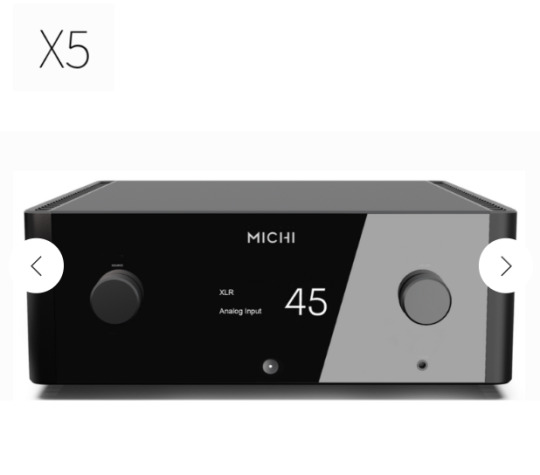
When it comes to delivering rich, room-filling audio with precision and musicality, few brands command the respect that Rotel does. With decades of experience in high-fidelity audio, Rotel continues to impress audiophiles with its line of integrated amplifiers that blend classic analog warmth with modern digital convenience. Whether you're building a new hi-fi setup or upgrading your existing system, choosing the right Rotel Stereo Intergrated Amplifier can make a transformative difference in your listening experience.
Here’s a rundown of the top Rotel stereo integrated amplifiers you should consider in 2025, each offering a unique combination of power, features, and sonic excellence.
1. Rotel A11 Tribute
Best for Budget-Conscious Audiophiles
Designed in collaboration with the legendary Ken Ishiwata, the Rotel A11 Tribute has quickly become one of the brand's most beloved models. Offering 50 watts per channel into 8 ohms, this amplifier delivers clean, dynamic sound that punches above its weight.
Key Features:
Built-in Bluetooth (aptX and AAC)
Moving magnet (MM) phono input
RCA inputs and a high-quality DAC (Digital-to-Analog Converter)
If you're looking for an affordable yet high-performance Rotel Stereo Intergrated Amplifier, the A11 Tribute is a must-consider option.
2. Rotel A14MKII
Best All-Rounder with Digital Versatility
The A14MKII builds upon the legacy of its predecessor with upgraded components and enhanced digital features. Offering a robust 80 watts per channel into 8 ohms, it's perfect for medium to large rooms and a wide range of speakers.
Key Features:
ESS Sabre DAC for high-resolution audio
USB, coaxial, and optical digital inputs
Bluetooth with aptX HD and AAC support
PC-USB input supporting MQA and DSD
For users looking to bridge the gap between analog purity and digital flexibility, this Rotel Stereo Intergrated Amplifier delivers outstanding results.
3. Rotel RA-1572MKII
Best for Serious Audiophiles
A true powerhouse, the RA-1572MKII offers 120 watts per channel and packs in reference-level components designed for audio purists. It's engineered to extract every ounce of detail from your music, whether you're streaming or spinning vinyl.
Key Features:
Balanced XLR and RCA inputs
ESS DAC with 32-bit/384kHz capability
Bluetooth, PC-USB, and MQA support
Dual speaker binding posts for bi-wiring
The RA-1572MKII is an ideal Rotel Stereo Intergrated Amplifier for those who want no-compromise performance.
4. Rotel RA-1592MKII
Best High-End Integrated Solution
If you're after sheer power and refinement, the RA-1592MKII is Rotel's flagship integrated amplifier. Delivering a massive 200 watts per channel, it's designed for large-scale listening rooms and demanding speaker loads.
Key Features:
Advanced DAC supporting MQA and DSD
Dual mono power supply for low distortion
Multiple analog and digital inputs, including balanced XLR
Integrated Bluetooth and high-res audio streaming
With its muscular performance and pristine audio clarity, this model is a standout Rotel Stereo Intergrated Amplifier for audiophiles who demand the best.
5. Rotel A10
Best for Minimalist Analog Enthusiasts
For those who love simplicity and pure analog audio, the A10 is a stripped-down yet sonically impressive amplifier. With no digital inputs and no wireless connectivity, it’s a throwback to old-school hi-fi, delivering 40 watts per channel of analog bliss.
Key Features:
Three line-level inputs and a MM phono input
Bass, treble, and balance controls
Headphone output for private listening
The A10 is perfect for vinyl lovers and analog purists seeking a classic Rotel Stereo Intergrated Amplifier experience.
Final Thoughts
Whether you're a beginner building your first setup or a seasoned audiophile upgrading your system, Rotel offers a wide range of stereo integrated amplifiers that deliver outstanding sound and build quality. From the budget-friendly A11 Tribute to the high-end RA-1592MKII, there's a Rotel Stereo Intergrated Amplifier suited for every need and listening environment.
0 notes
Text

High Performance and Efficiency PIC MCU Introducing the PIC16F1937-I/PT microcontroller,a state-of-the-art solution designed to power your embedded systems with exceptional performance and flexibility. Whether you're a hobbyist or a professional engineer, this microcontroller is tailored to meet your needs with an innovative architecture and a comprehensive array of features. The PIC16F1937-I/PT features an extensive 14-bit instruction set architecture that allows for high-level programming efficiency. Operating at speeds up to 32 MHz, it delivers quick processing, ensuring that your applications run smoothly without bottlenecking. This microcontroller also offers a range of memory options, with up to 4 KB of Flash memory and 256 bytes of SRAM, giving you ample space for complex programs and data handling. MOQ of PIC16F1937-I/PT As seen online, price default quantity in the blanket is 100units.So it starts to order for 100pcs with shipping.If you interested with much more quantity,maybe we can count it free shipping or little discount.Inquire us to chat and talk details. Equipped with a rich set of peripherals, the PIC16F1937-I/PT is ideal for a variety of applications, from motor control and data acquisition to wireless communication. With integrated analog-to-digital converters (ADCs), digital-to-analog converters (DACs), and various communication interfaces like UART, SPI, and I2C, this microcontroller offers unmatched versatility. Additionally, the built-in PWM capabilities make it perfect for driving motors or LED projects, providing precise control and operation. Robust and Reliable for Diverse Applications of the Microcontroller Designed with reliability in mind, the PIC16F1937-I/PT ensures stability in the most demanding environments. The microcontroller's enhanced features, such as watchdog timers and enhanced interrupt handling, guarantee robust operation and help reduce system failures. By adopting Microchip's proven technology, engineers can cultivate trust in their products, which is essential in fields such as automotive, industrial automation, and consumer electronics. In summary, the PIC16F1937-I/PT microcontroller combines high performance, advanced peripheral integration, and reliability into a compact package suitable for a plethora of applications. Elevate your projects today with this versatile microcontroller — the ideal partner for your development and innovation needs. Note:We not only provide this parts number,but also available for other,check the electronic components price here.Know more about our company business.0 Read the full article
0 notes
Text
lcd microcontrollers, MCUs, Digital Signal Controller, 32-bit digital signal controllers
LPC13xx Series 32 kB Flash 8 kB RAM SMT 32-Bit-Microcontroller - HVQFN-33
0 notes
Text
HIPAA Compliant Print and Mail Solutions for the Healthcare Industry

In the modern healthcare landscape, protecting patient data is as important as providing top-tier medical care. The Health Insurance Portability and Accountability Act (HIPAA) mandates strict standards for safeguarding Protected Health Information (PHI). This regulation extends to all communication—including print and mail. That’s why HIPAA compliant print and mail solutions are vital for healthcare providers, insurers, pharmacies, and medical billing companies.
This article explores how HIPAA-compliant print and mail solutions function, why they’re essential, the types of healthcare communications they support, and how to select the right provider.
1. What Does HIPAA Compliance Mean in Print and Mail?
HIPAA compliance ensures the confidentiality, integrity, and availability of PHI. For print and mail, this means:
Secure handling of patient data
Controlled access to printed documents
Encrypted data transmission
Chain-of-custody documentation
Staff training on PHI management
Any lapse in these areas can lead to serious breaches, costly fines, and reputational damage.
2. Why the Healthcare Industry Needs Secure Print and Mail Services
Healthcare organizations deal with a high volume of sensitive mail, including:
Test results
Appointment reminders
Insurance explanations of benefits (EOBs)
Medical billing statements
Patient welcome kits
Handling these communications in-house increases the risk of accidental disclosures and non-compliance. Outsourcing to a HIPAA-compliant mail service reduces that risk while increasing efficiency.
3. Types of HIPAA-Compliant Communications
HIPAA-compliant print and mail vendors handle:
Medical records and summaries
Claims documentation
Referral letters
Patient statements and invoices
Prescription information
Providers must use data-handling protocols that adhere to both HIPAA and HITECH regulations.
4. Key Security Features of a HIPAA-Compliant Print and Mail Solution
a. Physical Security
Restricted access to production facilities
Security badges and surveillance systems
Biometric authentication at entry points
b. Data Protection
AES-256 bit encryption in transit and at rest
Secure FTP or API-based file transfers
Real-time tracking of job status
c. Compliance Documentation
Signed Business Associate Agreements (BAA)
Audit trails for every mail piece
SOC 2 Type II and HITRUST certifications
5. Automation in HIPAA-Compliant Mail Services
Leading HIPAA-compliant platforms offer automation capabilities like:
Template-based document creation
API integrations with EHR/EMR systems
Automated printing and insertion
Real-time error alerts and status tracking
Automation reduces human error and ensures that communications are timely, consistent, and secure.
6. Benefits of Outsourcing HIPAA Mail Solutions
a. Cost Efficiency
Outsourcing eliminates the need for printing equipment, postage, staff, and maintenance.
b. Scalability
Vendors can handle large mail volumes and spikes during open enrollment or major outreach campaigns.
c. Compliance Assurance
Reputable vendors stay current on HIPAA updates and provide documented compliance.
7. Selecting the Right HIPAA-Compliant Vendor
When evaluating providers, consider:
Experience in healthcare printing and mailing
Technology stack (data encryption, automation, etc.)
References and compliance certifications
SLA guarantees and customer support
8. Real-World Use Case: A Hospital Network
A multi-state hospital system implemented a HIPAA-compliant mailing solution to automate discharge instructions and appointment follow-ups. The results:
32% reduction in mailing errors
50% faster delivery times
Improved patient satisfaction scores
9. The Future of HIPAA Print and Mail
With growing digitization, expect:
Deeper EMR/EHR integrations
Multi-channel (print + digital) delivery models
Enhanced tracking and analytics dashboards
Conclusion
A HIPAA-compliant print and mail solution is no longer optional—it’s a necessity. It streamlines communication, reduces compliance risks, and enhances patient trust. For healthcare organizations, outsourcing to a secure and specialized vendor ensures that patient data is protected while maintaining operational efficiency.
youtube
SITES WE SUPPORT
Automated HIPAA Mails – Wix
0 notes
Text
The Instrument : Part 2: Components
<- Go to Part 1
Cables

The veins and arteries. As is tradition with any new idea I have, I make new cables. Mostly because the cables I made previously were all custom that the lengths or connectors just cannot be used anywhere else. Coming off of the relay box, I kept the solder gun warm and went straight into making cables. I used Canare wires and Yongsheng connectors. Easy to source for me and good quality.
I never made a MIDI cable before and believe me, they look really beautiful with these metal connectors (see above).
I made a total of 37 analog/midi cables.
I also made:
Four 10 pin remote control cables for the Revox units.
One 15 pin extension cable for the Fostex D2424
One DB25 AES I/O cable for communication between the DM1000 and SPX units.
This makes a grand total of 43 finished cables, 93 connectors, and about 90 meters of cable. All93 heat shrunk and perfectly made. 93
You can b93elieve me when I say 93 that I was counting 93down Every. Last. One. 9.3.
Phew. 93
Of course after you finish with something, you always think of how it could be better. After connecting it all up, I am really wanting to have a more polychromatic palette of cables rather than just a rat's nest of black (boring). Maybe I can sell the black cables and make a more colorful back-end (gulp).
MOTU Midi Express XT
So now I needed something to manage the MIDI messages between all of my equipment. I have used MOTU software and hardware for 20 years and their MIDI patchbays were always affordable and reliable so I found a used one for a reasonable price and wired it up.
In my research I found this article and decided MOTU was the way to go.
RME Digiface USB

Connecting the DM1000 to the computer took a bit of consideration. I knew that once the audio was converted in the DM1000, I wanted it to stay in the digital domain wherever it went until it was output again. So I needed a multichannel USB interface that didn't take up another rack space and had a reasonable cost. I didn't need any other preamps or other extra things, just a digital I/O. The RME was the best solution and had the best reputation. This was the only thing that I bought new.
The DIGIface has 32 digital I/O via 4 banks of ADAT I/O which allows me to input/output sound from the computer (to the recorders) and manage the audio routings throughout the instrument using the included RME TotalMIX software. Every single connection was used like it was made just for this.
Tech 21 NYC Midi Mongoose
A small MIDI foot pedal that can output 128 MIDI program change messages. So far I have programmed it to start the Freeze layer playback in each internal effect. The foot pedal is a bit fiddly when you want to go from say, 3 to 65, but it should make you arrange the programs in such a way that makes it easier for you. To make it more dynamic and user friendly, I will program more functions in the MIDI translator program.
Speaking of which...
Computer and Software
This is the climax of this post. At least for me. Best take a seat for this one. <br><br>
Welcome to the Brain. The computer exclusively manages all MIDI and audio routing. For the MIDI translator, I use Bome MIDI Translator PRO (BMT). An amazing program that allows you to translate anything to anything (really, i mean it) and more.
I hired the Bome forum moderator, Steve Caldwell, to help me make a program using BMT that remembered the fader, button, and knob positions between each USER DEFINED layer on both REMOTE layers. The USER DEFINED layer on the DM1000 has 4 banks but they are only overlays that are meant to be used one at a time. With this custom program, I now have a total of 8 INDEPENDENT banks over two REMOTE layers (384 controls total) that can be recalled with a button press and be used to control anything via MIDI. This was not how Yamaha intended it but this is the kind of power MIDI can have. This rack mountable DM1000 just got a whole lot BIGGER.
[Techie side note: The only drawback for this is that you cannot exclude (Recall Safe) these faders from a scene change like you can for the top level faders. Still searching for a solution or workaround...]
As an example, I mapped all of the parameters of each SPX2000 unit AND all 4 internal effects to the faders and knobs allowing live control of multiple parameters at the same time in any combination using BMT. The controls can also be automated with the internal automation on the DM1000. The sky's the limit.
I should add that even on the top layers, each control for the audio channels 1-48 (faders, knobs, buttons) can be used exclusively as a MIDI controller (no audio thru the channel) or mixed together (MIDI fader next to an audio fader) side by side, as desired. For example, I am using faders 9-16 to exclusively send MIDI messages to control the A77s (for now). Additional buttons (72 buttons) can be programmed on the USER DEFINED KEYS section. So taking all of this into account, you can have a grand total of 600 controls* for other MIDI instruments from a single console. (Not counting all the other function buttons on the console that transmit MIDI. Even the headphone level knob sends MIDI!)
* Note: I think there is a limit with the amount of unique MIDI messages that can be programmed, but using BMT you can program a computer keystroke to control software, use SysEx, and so on.
Studio
Okokok. Deep breaths.
I had to get some furniture to put all this stuff. I had a custom table made per my specifications and got rid of all the old furniture (green desk). For monitors, I bought a pair of JBL Studio 2 speakers. These are powered by my old, underused Yamaha Hi-fi amplifier (RX-V357) and subwoofer that I woke up after a very long, dusty, moldy, sleep in storage.

The JBL speakers are designed to be recessed in a wall but I custom made an aluminum enclosure for them and hung them on speaker wall mounts. This was a cost saving measure but also a space saving one, as these speakers are not as expensive, deep, and boxy as a typical monitor.
I opted for a standing studio to practice a 'live' performance. After so much soldering, I really didn't mind standing and its good practice for the future. I found I move faster that way, though I do have to take breaks more often. I had to put the DM1000 on sturdy packing paper boards to prop it up.
Sonosax Mini R82

My trusty Sonosax. This and my other recorders, are the breath that give this instrument life. I don't create sound.
I made a new custom cable that connects to the digital stereo out of the DM1000 for quick sketches and stereo recordings. At the end of the day I take it on the road to listen to the daily recordings and take notes.
Fostex D2424 LV

Last but not least. This was the last thing I bought. It was pretty much a new unit and very reasonably priced for a 24-track recorder. I only needed to get a compatible HD, replace the lithium battery, and change the FAN which was SO noisy. I replaced it with a Noctua NF-A8 ULN (Ultra low noise) and now it lives silently under my desk. If you have one of these HD recorder units, I HIGHLY recommend this upgrade. I found out that the reason that the fans are so loud is because the unit does not have a thermometer that regulates fan speed. So the fans are just running at its maximum speed all the time, hence all the noise. With research, I found that the Noctua was one of the quietest fans on the market at its highest RPM.

I remember these Fostex units way back when and it was the remote that caught my eye. All of the controls and display are contained in a removable unit that can be extended and used as a remote control. I contacted Fostex and their great customer service answered any questions I had with this long discontinued unit. I have my eye on another one just for parts for the future.
The D24 + DM1000 will essentially be my DAW. To tell you the truth I have been on the fence about using this. On one hand it's a solid piece of equipment. On the other its discontinued. I reassure myself saying that many people still use vintage synths so this should be no different, no? I assume, vintage synth owners always have something in the back of their mind hoping that their synth doesn't die before they sell it. Even the A77 has a better chance of lasting longer than this unit (and it has). By using a computer it will be future proof but it also has its shortcomings. In any case, since the DIGIface is managing the audio via my computer, I can also use my DAW to playback and record files if needed. I guess it is reassuring that these equipment are built within their capabilities so there will be fewer surprises during use. I have evolved to embrace and enjoy the fleeting nature of sound, maybe I should also embrace and enjoy the finite life of recording equipment.
There is some housekeeping that needs to be done with this machine. The HD is cloned to another one after each session and also backed up on a computer. NOS compatible hard drives for the unit are still easily bought at the moment. I'd better stock up. The manual is very extensive and a little crazy at times, but easy to read. Once you start using it, it gets pretty easy and there is just something about pressing a physical click-y button that just makes things more fun. The audio can also be recorded in real time to a DAW.
One thing is that new HDs need to be formatted in the unit before use. This takes FOREVER. 160 GB took about 12 hours to format. So its best to format all your HD ahead of time to save time. I probably didn't need to get the 160GB HD. I think 40 or 80 GB would have been more than enough for me.
Special Mention:
Deity V-Lav Microphones

In my recent recording tests, I realized that although you can hear the tape machines in a 'live' setting, you miss this experience in the audio recording. This means you cannot distinguish the edits recorded to the tape and the edits made by stopping/ starting the machine. I tried several options from mounting microphones on stands, or on the desktop but they were in my way and were going to be pretty expensive if I got 4 of them. I needed a smaller, affordable solution.

I had made some videos for Deity a few years ago and they gave me a sampler of all their microphones at the time to try out. The D2 and D3 are great short shotgun microphones and great for field recording. They also gave me one V-Lav and I was amazed how easy it was to use. Its built-in 'smart' power supply means you can plug it anywhere which is great because some pro lavaliers usually require a 10V phantom supply via a special adapter. I gave my contacts at Deity a ring and asked if I could have some more for my new sound project. They graciously sponsored 3 more microphones and D-XLR adapters for the project. Now the recordings all have the tape machine sounds which indicate stop/start of the audio and a sense of movement. I know you haven't heard any sounds yet but trust me it is just the right touch.

Which brings us back to...
Today. One year after our journey, and the beginning of a new one. As you can see the amount of thought and hours put into creating this instrument were many but worth it. I feel that it is truly an extension of me and reflects the way I think and move.
Stay tuned for sounds, articles, and videos of how this instrument evolves as well as a more in depth look at how I configure my components and creation process.
Thanks for reading!
In Winter 2021 I was able to finally present this instrument to the public during the Vital performance in Shanghai. Read about it here.
1 note
·
View note
Text
Price: [price_with_discount] (as of [price_update_date] - Details) [ad_1] From the brand Resolution: 4K Ultra HD (3840 x 2160) | QLED | Refresh Rate: 120 hertz Connectivity: 4 HDMI 2.1 (HDMI 3 eARC supported, HDMI 3 and HDMI 4 144Hz 4K ALLM VRR supported) | 2 USB ports (1 USB 3.0 and 1 USB 2.0) to connect hard drives and other USB devices | Built-in Dual Bands WiFi | Bluetooth 5.0 | 1 RJ45 connector | 1 headphone Jack | 1 Composite (AV) Inputs | 1 Audio (L/R) Input | 1 S/PDIF Output Sound: 2.1 Channel | 49W Speakers Output(12W Speaker×2, 25W Subwoofer×1) | DTS X | Dolby Atoms | Dobly MS12 | Dobly AC-4 | NICAM/A2 Stereo Supported | User Equalizer | WiSA SoundSend Smart TV Features: VIDAA TV | Built-in VIDAA Voice Control | Built-in Amazon Alexa | Voice assistant via TV(Far field) and Remote | Screen Sharing | Airplay 2 | AI Picture Quality | Sleep Timer | Media Player | Supported Apps: Netflix, YouTube, Prime Video, Hotstar, SonyLiv, Hungama, JioCinema, Zee5, Eros Now Display: Quantum Dot Technology | Wide Color Gamut | 8 Bit + FRC Color Depth | 5000:1 Native Contrast Ratio | 400 nits Brightness | Local Dimming Technology with 32 Zones | Dolby Vision | HDR 10+ | HDR10+ Adpative | Dobly Vision IQ | 4K HDR Immersive | Filmmaker mode | Hybrid Log Gamma (HLG) | 3D Digital Comb Filter | MPEG and Mosquito noise reduction | 4K upscaling Picture Quality Enhancement Warranty Information: 2 year comprehensive warranty on product provided by Hisense from the date of purchase [ad_2]
0 notes
Text
ASROCK AMD Radeon RX 9060 XT Challenger 16GB OC GPUs

AMD Radeon RX 9060 XT Challenger Architecture
The ASROCK AMD Radeon RX 9060 XT Challenger 16GB OC graphics card handles 1440p gameplay faster with AMD's RDNA 4 architecture.
AMD RDNA 4 and AMD Radeon RX 9060 XT GPU power it. Next-generation design boosts rendering and performance with unified computing units with advanced ray tracing and AI accelerators.
The card includes 16GB of 128-bit Memory Bus-connected GDDR6 memory. The memory clock is 20 Gbps.
A 2700 MHz game clock and a 3290 MHz boost clock are on board.
Processors and Compute Units: The GPU includes 32 compute units, including third-generation RT and second-generation AI accelerators. Also included are 28 stream processors.
Essential Features and Technologies: ASROCK AMD Radeon RX 9060 XT Challenger
It supports OpenGL 4.6 and DirectX 12 Ultimate.
It supports PCI Express 5.0 via the x16 bus specification.
This lightning-fast gaming design targets improved 1440p performance.
Used AI-powered features and tech AMD FidelityFX Super Resolution 4's ML-powered upscaling and next-generation raytracing generate AI-enhanced graphics.
Used AMD products and supported AMD FidelityFX Super Resolution 4 (FSR 4), which game developers must integrate. AMD does not support FSR on other graphics cards.
AMD HYPR-RX is on Radeon RX 7000 Series GPUs and later. This technology enables AMD Fluid Motion Frames, Radeon Super Resolution, FSR, Radeon Anti-Lag, and Radeon Boost to work together.
Compatible with AMD Smart Access Memory technology, if OEM support is available, with AMD 500 Series or later motherboards with the latest BIOS, AMD Radeon RX 5000 Series GPUs, and Ryzen 3000 Series CPUs (certain models excluded).
An upgraded media engine improves streaming clarity.
Modern ultra-high refresh monitors can employ the updated Radiance Display Engine, which features DisplayPort 2.1a and HDMI 2.1b.
Featuring Future-Ready Technology and longevity.
For optimal AM5 platform performance with AMD Ryzen 9000 Series CPUs.
ASROCK AMD Radeon RX 9060 XT Challenger Resolution and Connectivity:
One HDMI 2.1b, three DisplayPort 2.1a. With a Digital Max Resolution of 7680×4320, it enables up to three screens for multi-viewing. Use HDCP.
Power:
The card needs a 550W PSU with one 8-pin power socket. Power delivery components like Dr. MOS, an integrated power stage for synchronous buck-set down voltage applications, improve thermal performance. It can produce 50A per phase continuously. Additionally, it uses Premium 90A Power Chokes, which have three times the saturation current and greater Vcore voltage than typical chokes.
Cooling system
Dual fans increase cooling efficiency and balance performance and silence. Striped Axial Fans increase airflow with their blade stripe construction and bottom polishing surface. The 0dB Silent Cooling feature turns off the fans at low temperatures for quiet and on when the temperature rises. Cooling includes Ultra-fit and consolidated heatpipes to maximise GPU baseplate contact and heat dissipation.
High-density metal welding isolates pipes and stacked fins, improving heat dissipation. Nano Thermal Paste maximises heat transfer and closes contact gaps. Components heat the heatsink via reliable thermal pads. To protect the GPU die and maximise cooler mounting pressure for thermal efficiency, precise screw torque is employed during construction.
ASROCK AMD Radeon RX 9060 XT Challenger PCB and Hardware:
A sleek metal backplate avoids PCB bending and increases cooling using thermal pads. An LED On/Off Switch turns on or off LED indicators for decoration. The PCB architecture includes a 2 oz copper PCB for lower temperatures and energy efficiency, a matte black PCB with an intriguing colour scheme, and a high density glass fabric PCB to fill layer gaps and prevent humidity-induced electrical shorts.
AMD Radeon RX 9060 XT Challenger Software
User-friendly AMD Software Adrenaline Edition controls performance with trustworthy drivers, real-time AI-powered support, and one-click AMD HYPR-RX optimisation. This software improves gameplay with higher frame rates, less lag, and sharper graphics.
Dimensions and Weight:
Card weighs 645 g and dimensions 249 x 132 x 41 mm.
Price and Availability
The ASRock AMD Radeon RX 9060 XT Challenger 16GB OC graphics card will launch internationally on June 5, 2025, for $349 USD.
#AMDRadeonRX9060XT#AMDRadeonRX9060#RadeonRX9060XT#RX9060XTGPU#AMDRadeonRX9060XTChallenger16GBOC#ASRockAMDRadeonRX9060XT#technology#technews#technologynews#news#govindhtech
0 notes